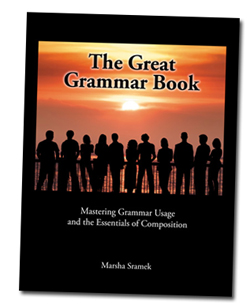The Great Grammar Book should be great for high school (as well as college students and adults) who have studied English grammar but still have some weak spots. It should also be helpful for ESL students. Most older students don’t need to start all over from the beginning, but they need to review common usage errors and sharpen their writing skills. This 268-page book begins with a 100-question diagnostic test which you can also download from the publisher’s website. The test will help you identify problem areas. Students can then study only those chapters or parts of chapters that are helpful.
The twelve chapters of the book highlight the most problematic areas: Subject-Verb Agreement, Common Errors (e.g., their/there/they’re), Pronouns, Capital Letters, Using Apostrophes Correctly, Complete Sentences, Punctuation, Commas, Irregular Verbs, Usage Glossary (works through glossaries of common usage errors), Double Negatives, and Successful Writing Strategies.
Each section within a chapter begins with brief instruction and one or more examples as we find in most grammar textbooks. Instruction is relatively brief, again assuming that students have already studied grammar in the past. For example, the eight parts of speech are presented briefly on the first four pages with definitions and examples. Then when we reach Chapter 3 on Pronouns, it begins immediately with pronoun agreement with antecedents, an area in which many writers make errors. It covers pronoun agreement with antecedents in number, person, and case as well as issues such as when to use "who" or "whom."
Intentionally, lessons skip over some basics such as identifying direct and indirect objects. In another example, the terms "nominative case" and "objective case" are used in one of the pronoun lessons with implied rather than explicit definitions. The focus is upon common areas of difficulty rather than spending a lot of time on basic instruction which most students have already received.
Each instructional section is followed by from one to three practice exercises with from 10 to 20 questions per exercise. This is more practice per topic than is provided in many grammar textbooks. There are also a number of chapter reviews within each chapter as well as a final chapter review. Chapter reviews are cumulative for their chapters, but there is no comprehensive test for the entire book.
Answer keys for exercises and chapter reviews are at the back of the book. You can also purchase the same book but without answers. However, you will still need the complete book to have access to the answer key. So you might purchase one book for the teacher and books without answers for each student. However, if you have only student, you might purchase the complete book, remove the answer key, and let the student use the book.
Twelve pages at the end of last chapter offer strategies for improving compositions, but there are no exercises or assignments for these pages. For example, after two sentences that describe the purpose of the introduction for an essay, it lists five specific ways that students might begin their essay such as with an example or an anecdote or with a startling fact. Another page presents a number of ideas to stimulate thinking for students who have to write their autobiography.
An index at the back of the book and the table of contents at the front both help students or teachers locate topics that need to be covered.
The Great Grammar Book has an unusual layout, but the content of the practice sentences is also unusual. Many practice sentences offer fun and fascinating trivia such as “Spaghetti and Venetian blinds both originated in China…” (p. 91), “Japanese children cover their tummies when they hear thunder to keep the Thunder Oni demon from stealing their belly buttons” (p. 127), and “IKEA founder Ingvar Kamprad lives in a small home, eats at IKEA, takes the bus, and [flies] coach despite being the 5th richest man in the world” (p. 191). Topics in the sentences seem to target a college to adult level audience, but they are appropriate for teens. You can get a good sense of the types of sentences used from the diagnostic test.











